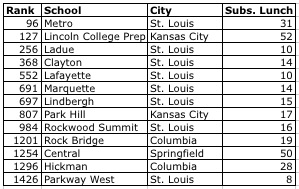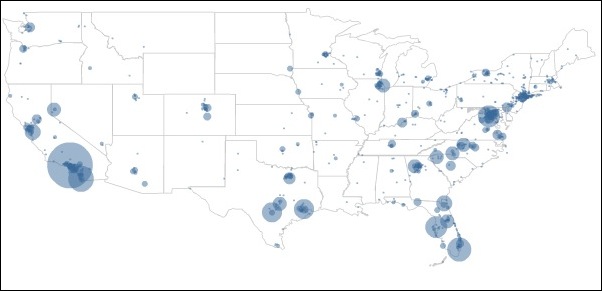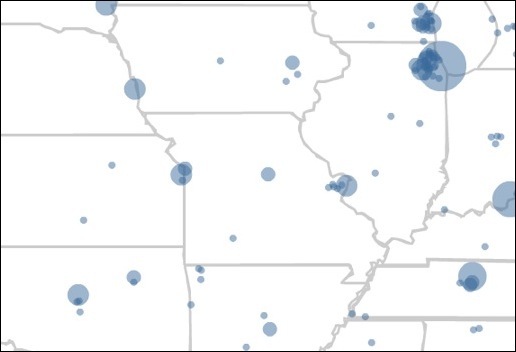Best high schools list out

The perennial Newsweek best high school list compiled by Jay Mathews is out again. Valid criticisms of the list may be made, but the criteria is clear, is easy to understand and has changed the education landscape.
Only 13 schools from Missouri made the list, but at least that is up one from last year. In St. Louis Eureka dropped off the list, but Parkway West made it.
Kansas City only has one non-selective school on the list versus seven for St. Louis. There are, however, four high schools on the list on the Kansas City, Kansas side. Both high schools in Columbia made the list, which is impressive. The Springfield high school with 50 percent on subsidized lunch that made the list is not, as far as I can tell, selective. I believe that is the high school closest to the university, which may skew the subsidized lunch demographics, but those numbers are still impressive.
In 2005 St. Louis schools dominated the 10 schools from Missouri that made the list with only Lincoln College Prep, Hickman in Columbia and Park Hill in Kansas City rounding out the list. Lafayette in St. Joseph made the list in 2006, which would be nice to see return.
I think the geographical map of the top 1300 schools is interesting with a sea of blue on the coasts and in Florida.

I zoomed in on Missouri and the surrounding states, which show blue in the urban areas with some pinpricks in some college towns.

With Missouri Virtual Instruction Program offering AP courses (pdf), students in rural schools now have more opportunities to take advanced classes. I would like to see more rural schools make the list.
Schools have to continually increase the percentage of students taking AP/IB exams just to stay on the list. For example, Ladue improved its index number from last year but dropped in rank. This is meant to be a “race to the top,” where the top means access to challenging courses for as many students as possible.
A new, non-researched phenomenom has begun in which some schools are all-out embracing the AP courses as a challenge for struggling students in coursework that doesn’t require prerequisites.
The rise of high-participation, low-passing-rate AP schools like Bell and Hogan has led NEWSWEEK this year to put them in a separate category, the Catching-Up list, for schools that have met the NEWSWEEK standard for college-level test participation but have AP passing rates below 10 percent. Once such schools pass the 10 percent passing mark, they will have about the same number of passing tests as the average American school, where passing rates are higher but participation is much lower. (AP Programs as Educational Shock Therapy)
Two high schools in Kansas City are using this approach. We’ll watch to see how they do next year.
Missouri ranges from 10 to 13 schools on the last from year to year. Next year, I would like to see that change and blown away.
Students taking AP classes in Mo., or not
My Humps—Calculus
Students in Missouri are not taking AP courses at nearly the same levels as in other states according to the College Board annual report released earlier this week (Wed. Feb. 13). In Mo. 10.6 percent of students take an AP class versus 24.9 percent national average. We're at less than half the national average.
Nationally, 15.7 percent of students earn a 3 or higher on at least one AP exam; whereas, in Mo. only 6.7 percent do. In fact, Mo ranks 46th. (Yeah, the College Board recommends against ranking for a lot of valid reasons, but I did I did it anyway.)
Last summer, Mo. DESE sent out a press release praising the uptick in numbers of students taking the exam.
❝This year we sent more money to Missouri classrooms than ever before and also secured funding to encourage even more students to take AP classes, including training for more AP teachers and assistance to help cover the cost of AP exams. It is clear by our students’ outstanding performance that our investments are helping our students prepare for the challenges ahead,❞ he [Gov. Matt Blunt] said.
However, the 2.0 percent increase in the past 5 years is quite a bit less than the national average of 3.5 percent increase. Our students are falling behind.
It's possible students here are taking AP courses but not the exam. Adding in IB classes wouldn't raise the rates much since only a few high schools here offer them (Lindbergh, Metro). However, I wonder if St. Louis University's 1-8-1-8 program decreases students motivation to take the AP exam.
I couldn't find numbers on students in Mo. taking AP courses, but I did look up a few districts' offerings to compare to the national average (9). Clayton offers 21 AP courses including Calculus BC, Music theory and Macroeconomics. Hazelwood offers 15 including Computer Science and Physics. I also looked up a rural district and chose DeSoto at random. I couldn't find evidence they offered any AP courses. I didn't see any listed in the course schedule (except possibly calculus); nor were any mentioned in the student handbook. They are proposing a college prep certificate starting class of 2010. If that is reflective of rural districts, Mo. is in trouble.
Missouri has started two centers at Truman and SeMo to help train teachers to teach AP courses. This is a good start but not enough.
But, but, why isn't MYYYYY school on the Best Schools List?
The Newsweek list, compiled by Jay Mathews, uses the number of AP and IB exams a high school gives as its sole criteria. The idea is that students can improve their academics by taking AP courses. The idea is that any school can improve its rankings by encouraging more students to take the exams. While the list has its faults, the criterion is easy to understand. In St. Louis the better high schools are ranked higher, so it seems to make sense.
The new US News & World Report list though is different. The methodology is complex. A high school has to have its economically disadvantaged and minority populations outperform the state average on state tests. The focus here is on the achievement gap, which I will post on another time. If it passes this criteria, a college readiness score is given based on AP tests, both # given and average scores. High ranking schools are then slated into three categories: gold, silver and bronze.
While I appreciate the attempt to measure multiple factors and applaud overperforming schools, I have several concerns about this method of ranking:
☹Mixing of methods. Since the bronze high schools don't include college readiness scores, they should be treated as a separate ranking. When I looked up the state proficiency scores for the Missouri bronze scores, they were often fairly low. Most parents aren't going to read complicated methodology papers (pdf) demonstrating that these aren't actually the "best" but overperforming in some statistical manner.
☹Mismatch between audience and methodology. Jay Mathews explained this one well:
❝Our focus is not what works for policy makers but what is most useful for readers, particularly parents, trying to judge the quality of their local schools and others that might be available to them.❞
The overperforming schools list would be better given in Phi Delta Kappan than a general magazine.
☹Too many criteria. Yes, I know what is best is determined by what priorities someone has. That is why the Newsweek list works―people know what is being measured. If Andy Rotherham wants to focus on broader criteria, multiple lists would be more helpful for parents. I enjoyed clicking through the top magnet schools, top open enrollment etc.
☹Regional lists. If you don't live on the coasts or in other large states, you must not have any good schools―at least according to people who do these rankings. I don't know how the numbers work that way, but those of us in flyover country are used to being overlooked, but we have excellent college prep public high schools too.
In Missouri only Metro (St. Louis city's gifted magnet school) and Rock Bridge (suburban Columbia) made the silver list. No one disputes that these two are great high schools, and of course Metro has great numbers as it's selective, but I contend that some of the St. Louis county schools are as strong as Rock Bridge.
27 Missouri high schools are on the bronze list, but none of them are in St. Louis county. These are in the overperforming for their demographics but not necessarily strong schools category. I'll make a separate post with detailed numbers since this one is already long.
I think most parents would prefer a clearer, easier to understand list that actually gives usable information. Here's to modifications for next year!